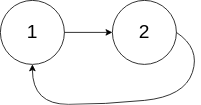给定一个链表的头节点 head ,返回链表开始入环的第一个节点。 如果链表无环,则返回 null。
如果链表中有某个节点,可以通过连续跟踪 next 指针再次到达,则链表中存在环。 为了表示给定链表中的环,评测系统内部使用整数 pos 来表示链表尾连接到链表中的位置(索引从 0 开始)。如果 pos 是 -1,则在该链表中没有环。注意:pos 不作为参数进行传递,仅仅是为了标识链表的实际情况。
不允许修改 链表。
示例 1:
输入:head = [3,2,0,-4], pos = 1 输出:返回索引为 1 的链表节点 解释:链表中有一个环,其尾部连接到第二个节点。
示例 2:
输入:head = [1,2], pos = 0 输出:返回索引为 0 的链表节点 解释:链表中有一个环,其尾部连接到第一个节点。
示例 3:
输入:head = [1], pos = -1 输出:返回 null 解释:链表中没有环。
提示:
- 链表中节点的数目范围在范围
[0, 104]内 -105 <= Node.val <= 105pos的值为-1或者链表中的一个有效索引
进阶:你是否可以使用 O(1) 空间解决此题?
先利用快慢指针判断链表是否有环,没有环则直接返回 null。
若链表有环,我们分析快慢相遇时走过的距离。
对于慢指针(每次走 1 步),走过的距离为 S=X+Y ①;快指针(每次走 2 步)走过的距离为 2S=X+Y+N(Y+Z) ②。如下图所示,其中 N 表示快指针与慢指针相遇时在环中所走过的圈数,而我们要求的环入口,也即是 X 的距离:
我们根据式子 ①②,得出 X+Y=N(Y+Z) => X=(N-1)(Y+Z)+Z。
当 N=1(快指针在环中走了一圈与慢指针相遇) 时,X=(1-1)(Y+Z)+Z,即 X=Z。此时只要定义一个 p 指针指向头节点,然后慢指针与 p 开始同时走,当慢指针与 p 相遇时,也就到达了环入口,直接返回 p 即可。
当 N>1时,也是同样的,说明慢指针除了走 Z 步,还需要绕 N-1 圈才能与 p 相遇。
# Definition for singly-linked list.
# class ListNode:
# def __init__(self, x):
# self.val = x
# self.next = None
class Solution:
def detectCycle(self, head: ListNode) -> ListNode:
slow = fast = head
has_cycle = False
while not has_cycle and fast and fast.next:
slow, fast = slow.next, fast.next.next
has_cycle = slow == fast
if not has_cycle:
return None
p = head
while p != slow:
p, slow = p.next, slow.next
return p/**
* Definition for singly-linked list.
* class ListNode {
* int val;
* ListNode next;
* ListNode(int x) {
* val = x;
* next = null;
* }
* }
*/
public class Solution {
public ListNode detectCycle(ListNode head) {
ListNode slow = head, fast = head;
boolean hasCycle = false;
while (!hasCycle && fast != null && fast.next != null) {
slow = slow.next;
fast = fast.next.next;
hasCycle = slow == fast;
}
if (!hasCycle) {
return null;
}
ListNode p = head;
while (p != slow) {
p = p.next;
slow = slow.next;
}
return p;
}
}/**
* Definition for singly-linked list.
* class ListNode {
* val: number
* next: ListNode | null
* constructor(val?: number, next?: ListNode | null) {
* this.val = (val===undefined ? 0 : val)
* this.next = (next===undefined ? null : next)
* }
* }
*/
function detectCycle(head: ListNode | null): ListNode | null {
let slow = head,
fast = head;
while (fast) {
slow = slow.next;
if (!fast.next) return null;
fast = fast.next.next;
if (fast == slow) {
let cur = head;
while (cur != slow) {
slow = slow.next;
cur = cur.next;
}
return cur;
}
}
return null;
}/**
* Definition for singly-linked list.
* struct ListNode {
* int val;
* ListNode *next;
* ListNode(int x) : val(x), next(NULL) {}
* };
*/
class Solution {
public:
ListNode *detectCycle(ListNode *head) {
ListNode* slow = head;
ListNode* fast = head;
bool hasCycle = false;
while (!hasCycle && fast && fast->next) {
slow = slow->next;
fast = fast->next->next;
hasCycle = slow == fast;
}
if (!hasCycle) {
return nullptr;
}
ListNode* p = head;
while (p != slow) {
p = p->next;
slow = slow->next;
}
return p;
}
};/**
* Definition for singly-linked list.
* function ListNode(val) {
* this.val = val;
* this.next = null;
* }
*/
/**
* @param {ListNode} head
* @return {ListNode}
*/
var detectCycle = function (head) {
let slow = head;
let fast = head;
let hasCycle = false;
while (!hasCycle && fast && fast.next) {
slow = slow.next;
fast = fast.next.next;
hasCycle = slow == fast;
}
if (!hasCycle) {
return null;
}
let p = head;
while (p != slow) {
p = p.next;
slow = slow.next;
}
return p;
};/**
* Definition for singly-linked list.
* type ListNode struct {
* Val int
* Next *ListNode
* }
*/
func detectCycle(head *ListNode) *ListNode {
slow, fast := head, head
hasCycle := false
for !hasCycle && fast != nil && fast.Next != nil {
slow, fast = slow.Next, fast.Next.Next
hasCycle = slow == fast
}
if !hasCycle {
return nil
}
p := head
for p != slow {
p, slow = p.Next, slow.Next
}
return p
}



